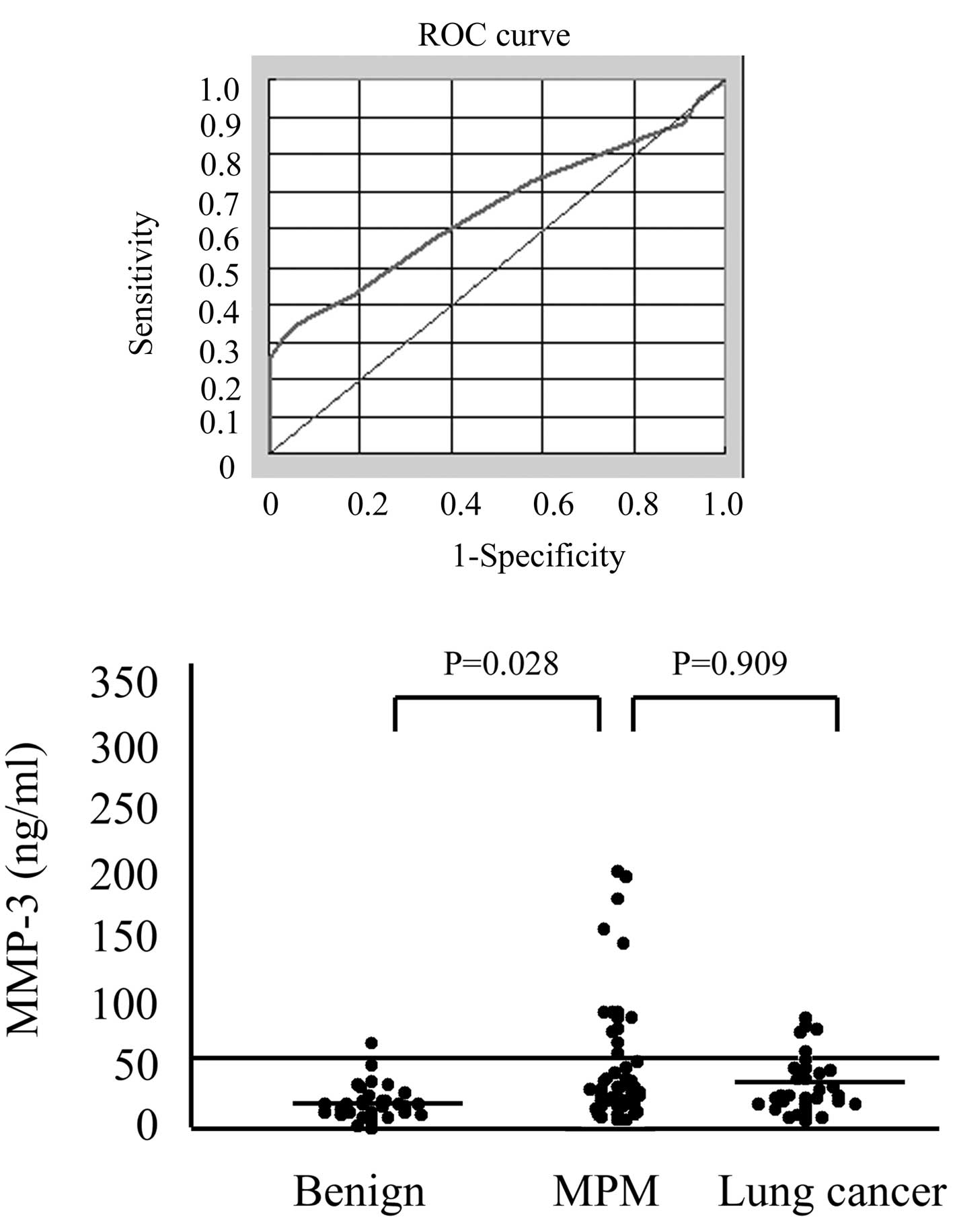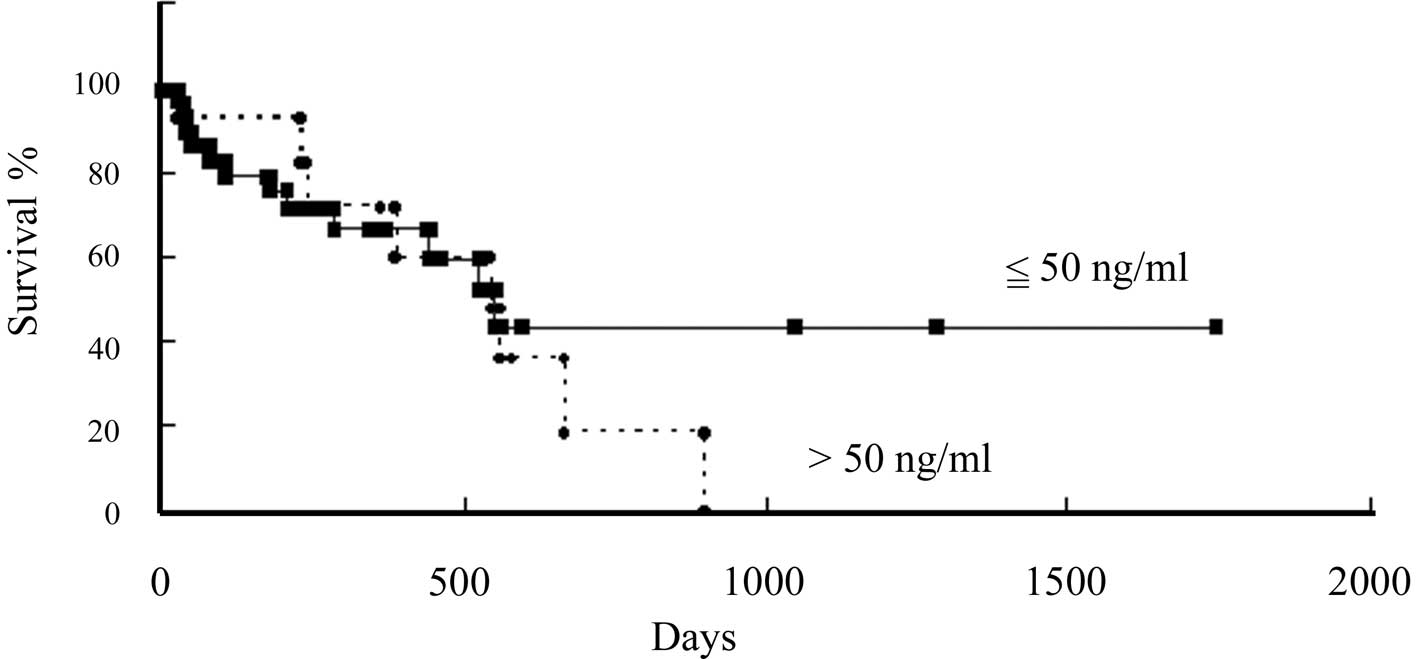|
1
|
Robinson BW, Musk AW and Lake RA:
Malignant mesothelioma. Lancet. 366:397–408. 2005. View Article : Google Scholar : PubMed/NCBI
|
|
2
|
Robinson BW and Lake RA: Advances in
malignant mesothelioma. N Engl J Med. 353:1591–1603. 2005.
View Article : Google Scholar : PubMed/NCBI
|
|
3
|
Wagner JC, Sleggs CA and Marchand P:
Diffuse pleural mesothelioma and asbestos exposure in the North;
Western Cape Province. Br J Ind Med. 17:260–271. 1960.PubMed/NCBI
|
|
4
|
Rake C, Gilham C, Hatch J, et al:
Occupational, domestic and environmental mesothelioma risks in the
British population: a case-control study. Br J Cancer.
100:1175–1183. 2009. View Article : Google Scholar : PubMed/NCBI
|
|
5
|
Selikoff IJ, Hammond EC and Seidman H:
Latency of asbestos disease among insulation workers in the United
States and Canada. Cancer. 15:2736–2740. 1980. View Article : Google Scholar : PubMed/NCBI
|
|
6
|
Liotta LA and Stetler-Stevenson WG:
Metalloproteinases and cancer invasion. Semin Cancer Biol.
1:99–106. 1990.PubMed/NCBI
|
|
7
|
Johnson LL, Dyer R and Hupe DJ: Matrix
metalloproteinase. Curr Opin Chem Biol. 2:466–471. 1998. View Article : Google Scholar
|
|
8
|
Kleiner DE and Stetler-Stevenson WG:
Structural biochemistry and activation of matrix metalloproteases.
Curr Opin Cell Biol. 5:891–897. 1993. View Article : Google Scholar : PubMed/NCBI
|
|
9
|
Mukherjee S, Roth MJ, Dawsey SM, et al:
Increased matrix metalloproteinase activation in esophageal
squamous cell carcinoma. J Transl Med. 8:912010. View Article : Google Scholar : PubMed/NCBI
|
|
10
|
Phromnoi K, Yodkeeree S, Anuchapreeda S,
et al: Inhibition of MMP-3 activity and invasion of the MDA-MB-231
human invasive breast carcinoma cell line by bioflavonoids. Acta
Pharmacol Sin. 30:1169–1176. 2009. View Article : Google Scholar : PubMed/NCBI
|
|
11
|
Lee EJ, Kim SY, Hyun JW, et al: Glycitein
inhibits glioma cell invasion through down-regulation of MMP-3 and
MMP-9 gene expression. Chem Biol Interact. 185:18–24. 2010.
View Article : Google Scholar : PubMed/NCBI
|
|
12
|
Yeh YC, Sheu BS, Cheng HC, et al: Elevated
serum matrix metalloproteinase-3 and -7 in H. pylori-related
gastric cancer can be biomarkers correlating with a poor survival.
Dig Dis Sci. 55:1649–1657. 2010.PubMed/NCBI
|
|
13
|
Okamoto K, Ishida C, Ikebuchi Y, et al:
The genotypes of IL-1 beta and MMP-3 are associated with the
prognosis of HCV-related hepatocellular carcinoma. Intern Med.
49:887–895. 2010. View Article : Google Scholar : PubMed/NCBI
|
|
14
|
Srivastava P, Mandhani A, Kapoor R, et al:
Role of MMP-3 and MMP-9 and their haplotypes in risk of bladder
cancer in North Indian cohort. Ann Surg Oncol. 17:3068–3075. 2010.
View Article : Google Scholar : PubMed/NCBI
|
|
15
|
Harvey P, Clark IM, Jaurand MC, et al:
Hepatocyte growth factor/scatter factor enhances the invasion of
mesothelioma cell lines and the expression of matrix
metalloproteinases. Br J Cancer. 83:1147–1153. 2000. View Article : Google Scholar : PubMed/NCBI
|
|
16
|
Liu Z, Ivanoff A and Klominek J:
Expression and activity of matrix metalloproteases in human
malignant mesothelioma cell lines. Int J Cancer. 91:638–643. 2001.
View Article : Google Scholar : PubMed/NCBI
|
|
17
|
Rusch VW: A proposed new international TNM
staging system for malignant pleural mesothelioma. From the
International Mesothelioma Interest Group. Chest. 108:1122–1128.
1995. View Article : Google Scholar : PubMed/NCBI
|
|
18
|
Vogelzang NJ, Rusthoven JJ, Symanowski J,
et al: Phase III study of pemetrexed in combination with cisplatin
versus cisplatin alone in patients with malignant pleural
mesothelioma. J Clin Oncol. 21:2636–2644. 2003. View Article : Google Scholar : PubMed/NCBI
|
|
19
|
Nowak AK, Lake RA, Kindler HL, et al: New
approaches for mesothelioma: biologics, vaccines, gene therapy, and
other novel agents. Semin Oncol. 29:82–96. 2002. View Article : Google Scholar : PubMed/NCBI
|
|
20
|
Pass HI, Lott D, Lonardo F, et al:
Asbestos exposure, pleural mesothelioma, and serum osteopontin
levels. N Engl J Med. 353:1564–1573. 2005. View Article : Google Scholar : PubMed/NCBI
|
|
21
|
Adachi Y, Aoki C, Yoshio-Hoshino N, et al:
Interleukin-6 induces both cell growth and VEGF production in
malignant mesotheliomas. Int J Cancer. 119:1303–1311. 2006.
View Article : Google Scholar : PubMed/NCBI
|
|
22
|
Tabata C, Tabata R, Hirayama N, et al:
All-trans-retinoic acid inhibits tumor growth of malignant pleural
mesothelioma in mice. Eur Respir J. 34:1159–1167. 2009. View Article : Google Scholar : PubMed/NCBI
|
|
23
|
Fitzpatrick DR, Bielefeldt-Ohmann H,
Himbeck RP, et al: Transforming growth factor-beta: antisense
RNA-mediated inhibition affects anchorage-independent growth,
tumorigenicity and tumor-infiltrating T-cells in malignant
mesothelioma. Growth Factors. 11:29–44. 1994. View Article : Google Scholar
|
|
24
|
Marzo AL, Fitzpatrick DR, Robinson BW, et
al: Antisense oligonucleotides specific for transforming growth
factor beta2 inhibit the growth of malignant mesothelioma both in
vitro and in vivo. Cancer Res. 57:3200–3207. 1997.PubMed/NCBI
|
|
25
|
Versnel MA, Claesson-Welsh L, Hammacher A,
et al: Human malignant mesothelioma cell lines express PDGF
beta-receptors whereas cultured normal mesothelial cells express
predominantly PDGF alpha-receptors. Oncogene. 6:2005–2011.
1991.
|
|
26
|
Mórocz IA, Schmitter D, Lauber B, et al:
Autocrine stimulation of a human lung mesothelioma cell line is
mediated through the transforming growth factor alpha/epidermal
growth factor receptor mitogenic pathway. Br J Cancer. 70:850–856.
1994.
|
|
27
|
Galffy G, Mohammed KA, Dowling PA, et al:
Interleukin 8: an autocrine growth factor for malignant
mesothelioma. Cancer Res. 59:367–371. 1999.PubMed/NCBI
|
|
28
|
Fuhrman C, Duche JC, Chouaid C, et al: Use
of tumor markers for differential diagnosis of mesothelioma and
secondary pleural malignancies. Clin Biochem. 33:405–410. 2000.
View Article : Google Scholar : PubMed/NCBI
|
|
29
|
Paganuzzi M, Onetto M, Marroni P, et al:
Diagnostic value of CYFRA 21-1 tumor marker and CEA in pleural
effusion due to mesothelioma. Chest. 119:1138–1142. 2001.
View Article : Google Scholar : PubMed/NCBI
|
|
30
|
Robinson BW, Creaney J, Lake R, et al:
Mesothelin-family proteins and diagnosis of mesothelioma. Lancet.
362:1612–1616. 2003. View Article : Google Scholar : PubMed/NCBI
|
|
31
|
Frebourg T, Lerebours G, Delpech B, et al:
Serum hyaluronate in malignant pleural mesothelioma. Cancer.
59:2104–2107. 1987. View Article : Google Scholar : PubMed/NCBI
|
|
32
|
Schouwink H, Korse CM, Bonfrer JM, et al:
Prognostic value of the serum tumour markers Cyfra 21-1 and tissue
polypeptide antigen in malignant mesothelioma. Lung Cancer.
25:25–32. 1999. View Article : Google Scholar : PubMed/NCBI
|
|
33
|
Creaney J, Yeoman D, Naumoff LK, et al:
Soluble mesothelin in effusions: a useful tool for the diagnosis of
malignant mesothelioma. Thorax. 62:569–576. 2007. View Article : Google Scholar : PubMed/NCBI
|
|
34
|
Edwards JG, McLaren J, Jones JL, et al:
Matrix metalloproteinases 2 and 9 (gelatinases A and B) expression
in malignant mesothelioma and benign pleura. Br J Cancer.
88:1553–1559. 2003. View Article : Google Scholar : PubMed/NCBI
|
|
35
|
Roomi MW, Monterrey JC, Kalinovsky T, et
al: Modulation of MMP-2 and MMP-9 by cytokines, mitogens and
inhibitors in lung cancer and malignant mesothelioma cell lines.
Oncol Rep. 22:1283–1291. 2009.PubMed/NCBI
|
|
36
|
Murphy GJ, Murphy G and Reynolds JJ: The
origin matrix metalloproteinases and their familial relationships.
FEBS Lett. 289:4–7. 1991. View Article : Google Scholar : PubMed/NCBI
|











